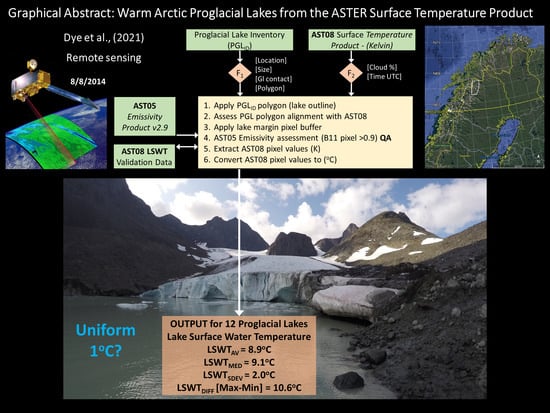Warm Arctic Proglacial Lakes in the ASTER Surface Temperature Product
Abstract
:1. Introduction
Aims and Objectives
- Provide one of the first validations of data from the AST08 surface temperature product against in situ lake body temperatures in maritime climates by using data from Arctic Sweden and Patagonia.
- Measure surface temperatures for the 12 largest proglacial lakes in Arctic Sweden using calibrated AST08 data and analyse inter-lake variability in relation to the climate.
- Analyse within-lake geospatial patterns in surface temperature to test the assumption that smaller lakes in contact with glacier termini have uniform temperatures of 1 °C and investigate the impacts of climate drivers and ice-contact on the LSWT across proglacial lakes greater than 129,600 m2.
- Assess summer proglacial lake surface temperature variability since 2000 using ASTER surface temperature product (AST08) data to investigate whether higher than 1 °C temperatures occur in several years and are not just associated with individual climate events.
2. Materials and Methods
2.1. Study Area
2.2. ASTER Satellite Data Used for the Extraction of the Lake Surface Water Temperature (LSWT)
2.3. Validation of AST08 with In Situ Observations from Lakes in Maritime Climates
3. Results
3.1. Validation of AST08 Data against In Situ Data from Lakes in Maritime Areas
3.2. Surface Temperatures (LSWT) for Proglacial Lakes in Arctic Sweden from AST08 Temperature Product in 2014
3.3. LSWT for Ice and Non-Ice-Contact Proglacial Lakes
3.4. Proglacial Lake Surface Temperature (LSWT) from AST08 since 2000
4. Discussion
4.1. Comparison to Reported Temperatures in Other Proglacial Lakes
4.2. Relationship between Topographic Microclimate and LSWT
4.3. LSWT Variability across Ice-Contact Proglacial Lakes
4.4. LSWT Variability across Non-Ice-Contact Proglacial Lakes
4.5. Influence of Meltwater on LSWT
4.6. Wider Considerations and Recommendations for Future Study
5. Conclusions
Author Contributions
Funding
Institutional Review Board Statement
Informed Consent Statement
Data Availability Statement
Acknowledgments
Conflicts of Interest
Appendix A
| Date | AST08 Time | AST08 Temp. (°K) | AST08 Temp. (°C) | Sensor Temp. (°C) |
|---|---|---|---|---|
| Kilpisjarvi | 69.033408°N | 20.77333°E | 0.75 m Depth | |
| 7 July 2014 | 10.46 | 283.7 | 10.55 | 7.41 |
| 11 July 2014 | 10.22 | 285.7 | 12.55 | 9.88 |
| 27 July 2014 | 10.21 | 291.7 | 18.55 | 15.98 |
| Kilpisjarvi | 69.02637274°N | 20.8027558°E | 1 m depth | |
| 13 June 2017 | 10.46 | 271.5 | −1.65 | 1.75 |
| 29 June 2017 | 10.46 | 277.8 | 4.65 | 3.20 |
| 4 August 2017 | 10.22 | 287.0 | 13.85 | 10.39 |
| Brazo Rico | 50.453°S | 73.023°W | <2 m depth | |
| 31 May 2011 | 3.57 | 276.7 | 3.55 | 3.55 |
| 31 May 2012 | 4.09 | 279.8 | 6.65 | 6.58 |
References
- Adrian, R.; O’Reilly, C.M.; Zagarese, H.; Baines, S.B.; Hessen, D.O.; Keller, W.; Livingstone, D.M.; Sommaruga, R.; Straile, D.; Van Donk, E.; et al. Lakes as sentinels of climate change. Limnol. Oceanogr. 2009, 54, 2283–2297. [Google Scholar] [CrossRef]
- O’Reilly, C.M.; Sharma, S.; Gray, D.K.; Hampton, S.E.; Read, J.S.; Rowley, R.J.; Schneider, P.; Lenters, J.D.; McIntyre, P.B.; Kraemer, B.M.; et al. Rapid and highly variable warming of lake surface waters around the globe. Geophys. Res. Lett. 2015, 42, 10–773. [Google Scholar] [CrossRef] [Green Version]
- Woolway, R.I.; Merchant, C.J. Worldwide alteration of lake mixing regimes in response to climate change. Nat. Geosci. 2019, 12, 271. [Google Scholar] [CrossRef]
- Merchant, C.J.; Matthiesen, S.; Rayner, N.A.; Remedios, J.J.; Jones, P.D.; Olesen, F.; Trewin, B.; Thorne, P.W.; Auchmann, R.; Corlett, G.K.; et al. The surface temperatures of Earth: Steps towards integrated understanding of variability and change. Geosci. Instrum. Methods Data Syst. 2013, 2, 305–321. [Google Scholar] [CrossRef] [Green Version]
- Schneider, P.; Hook, S.J. Space observations of inland water bodies show rapid surface warming since 1985. Geophys. Res. Lett. 2010, 37. [Google Scholar] [CrossRef] [Green Version]
- Hartmann, D.L.; Tank, A.M.; Rusticucci, M.J. IPCC fifth assessment report, climate change 2013: The physical science basis. Ipcc Ar5 2013, 5, 31–39. [Google Scholar]
- Richards, J.; Moore, R.D.; Forrest, A.L. Late-summer thermal regime of a small proglacial lake. Hydrol. Process. 2012, 26, 2687–2695. [Google Scholar] [CrossRef]
- Kirchner, N.; Kuttenkeuler, J.; Rosqvist, G.; Hancke, M.; Granebeck, A.; Weckström, J.; Weckström, K.; Schenk, F.; Korhola, A.; Eriksson, P. A first continuous three-year temperature record from the dimictic arctic–alpine Lake Tarfala, northern Sweden. Arct. Antarct. Alp. Res. 2021, 53, 69–79. [Google Scholar] [CrossRef]
- Huang, C.; Yunmei, L.; Liu, G.; Guo, Y.; Yang, H.; Zhu, A.X.; Song, T.; Huang, T.; Zhang, M.; Shi, K. Tracing high time-resolution fluctuations in dissolved organic carbon using satellite and buoy observations: Case study in Lake Taihu, China. Int. J. Appl. Earth Obs. Geoinf. 2017, 62, 174–182. [Google Scholar] [CrossRef]
- Fellman, J.B.; Nagorski, S.; Pyare, S.; Vermilyea, A.W.; Scott, D.; Hood, E. Stream temperature response to variable glacier coverage in coastal watersheds of Southeast Alaska. Hydrol. Process. 2014, 28, 2062–2073. [Google Scholar] [CrossRef]
- Box, J.E.; Colgan, W.T.; Christensen, T.R.; Schmidt, N.M.; Lund, M.; Parmentier, F.J.W.; Brown, R.; Bhatt, U.S.; Euskirchen, E.S.; Romanovsky, V.E.; et al. Key indicators of Arctic climate change: 1971–2017. Environ. Res. Lett. 2019, 14, 045010. [Google Scholar] [CrossRef]
- Serreze, M.C.; Francis, J.A. The Arctic amplification debate. Clim. Chang. 2006, 76, 241–264. [Google Scholar] [CrossRef] [Green Version]
- Sharma, S.; Blagrave, K.; Magnuson, J.J.; O’Reilly, C.M.; Oliver, S.; Batt, R.D.; Magee, M.R.; Straile, D.; Weyhenmeyer, G.A.; Winslow, L.; et al. Widespread loss of lake ice around the Northern Hemisphere in a warming world. Nat. Clim. Chang. 2019, 9, 227. [Google Scholar] [CrossRef]
- Edinger, J.E.; Duttweiler, D.W.; Geyer, J.C. The response of water temperatures to meteorological conditions. Water Resour. Res. 1968, 4, 1137–1143. [Google Scholar] [CrossRef]
- Schmid, M.; Hunziker, S.; Wüest, A. Lake surface temperatures in a changing climate: A global sensitivity analysis. Clim. Chang. 2014, 124, 301–315. [Google Scholar] [CrossRef]
- Truffer, M.; Motyka, R.J. Where glaciers meet water: Subaqueous melt and its relevance to glaciers in various settings. Rev. Geophys. 2016, 54, 220–239. [Google Scholar] [CrossRef] [Green Version]
- Caissie, D. The thermal regime of rivers: A review. Freshw. Biol. 2006, 51, 1389–1406. [Google Scholar] [CrossRef]
- Webb, B.W.; Hannah, D.M.; Moore, R.D.; Brown, L.E.; Nobilis, F. Recent advances in stream and river temperature research. Hydrol. Process. Int. J. 2008, 22, 902–918. [Google Scholar] [CrossRef]
- Pierre, K.A.S.; Louis, V.L.S.; Schiff, S.L.; Lehnherr, I.; Dainard, P.G.; Gardner, A.S.; Aukes, P.J.; Sharp, M.J. Proglacial freshwaters are significant and previously unrecognized sinks of atmospheric CO2. Proc. Natl. Acad. Sci. USA 2019, 116, 17690–17695. [Google Scholar] [CrossRef] [PubMed] [Green Version]
- Kirkbride, M.P. The temporal significance of transitions from melting to calving termini at glaciers in the central Southern Alps of New Zealand. Holocene 1993, 3, 232–240. [Google Scholar] [CrossRef]
- Warren, C.R.; Kirkbride, M.P. Temperature and bathymetry of ice-contact lakes in Mount Cook National Park, New Zealand. N. Z. J. Geol. Geophys. 1998, 41, 133–143. [Google Scholar] [CrossRef]
- Warren, C.R.; Kirkbride, M.P. Calving speed and climatic sensitivity of New Zealand lake-calving glaciers. Ann. Glaciol. 2003, 36, 173–178. [Google Scholar] [CrossRef] [Green Version]
- Röhl, K. Thermo-erosional notch development at fresh-water-calving Tasman Glacier, New Zealand. J. Glaciol. 2006, 52, 203–213. [Google Scholar] [CrossRef] [Green Version]
- Minowa, M.; Sugiyama, S.; Sakakibara, D.; Skvarca, P. Seasonal variations in ice-front position controlled by frontal ablation at Glaciar Perito Moreno, the Southern Patagonia Icefield. Front. Earth Sci. 2017, 5, 1. [Google Scholar] [CrossRef] [Green Version]
- Mallalieu, J.; Carrivick, J.L.; Quincey, D.J.; Smith, M.W. Calving seasonality associated with melt-undercutting and lake ice cover. Geophys. Res. Lett. 2020, 47, e2019GL086561. [Google Scholar] [CrossRef] [Green Version]
- Watson, C.S.; Kargel, J.S.; Shugar, D.H.; Haritashya, U.K.; Schiassi, E.; Furfaro, R. Mass loss from calving in Himalayan proglacial lakes. Front. Earth Sci. 2020, 7, 342. [Google Scholar] [CrossRef] [Green Version]
- Komori, J. Recent expansions of glacial lakes in the Bhutan Himalayas. Quat. Int. 2008, 184, 177–186. [Google Scholar] [CrossRef]
- Gardelle, J.; Arnaud, Y.; Berthier, E. Contrasted evolution of glacial lakes along the Hindu Kush Himalaya mountain range between 1990 and 2009. Glob. Planet. Chang. 2011, 75, 47–55. [Google Scholar] [CrossRef] [Green Version]
- Carrivick, J.L.; Quincey, D.J. Progressive increase in number and volume of ice-marginal lakes on the western margin of the Greenland Ice Sheet. Glob. Planet. Chang. 2014, 116, 156–163. [Google Scholar] [CrossRef]
- Hanshaw, M.N.; Bookhagen, B. Glacial areas, lake areas, and snow lines from 1975 to 2012: Status of the Cordillera Vilcanota, including the Quelccaya Ice Cap, northern central Andes, Peru. Cryosphere 2014, 8, 359–376. [Google Scholar] [CrossRef] [Green Version]
- Magnusson, J.; Jonas, T.; Kirchner, J.W. Temperature dynamics of a proglacial stream: Identifying dominant energy balance components and inferring spatially integrated hydraulic geometry. Water Resour. Res. 2012, 48. [Google Scholar] [CrossRef] [Green Version]
- Chikita, K.; Jha, J.; Yamada, T. Hydrodynamics of a supraglacial lake and its effect on the basin expansion: Tsho Rolpa, Rolwaling Valley, Nepal Himalaya. Arct. Antarct. Alp. Res. 1999, 31, 58–70. [Google Scholar] [CrossRef]
- Wessels, R.L.; Kargel, J.S.; Kieffer, H.H. ASTER measurement of supraglacial lakes in the Mount Everest region of the Himalaya. Ann. Glaciol. 2002, 34, 399–408. [Google Scholar] [CrossRef] [Green Version]
- Jonsell, U.; Hock, R.; Duguay, M. Recent air and ground temperature increases at Tarfala Research Station, Sweden. Polar Res. 2013, 32, 19807. [Google Scholar] [CrossRef]
- Kim, S.; Sinclair, V.A.; Räisänen, J.; Ruuhela, R. Heat waves in Finland: Present and projected summertime extreme temperatures and their associated circulation patterns. Int. J. Climatol. 2018, 38, 1393–1408. [Google Scholar] [CrossRef]
- Karlén, W. Holocene glacier and climatic variations, Kebnekaise mountains, Swedish Lapland. Geogr. Ann. Ser. A Phys. Geogr. 1973, 55, 29–63. [Google Scholar] [CrossRef]
- Sabol, D.E., Jr.; Gillespie, A.R.; Abbott, E.; Yamada, G. Field validation of the ASTER temperature–emissivity separation algorithm. Remote Sens. Environ. 2009, 113, 2328–2344. [Google Scholar] [CrossRef]
- Gillespie, A.; Rokugawa, S.; Matsunaga, T.; Cothern, J.S.; Hook, S.; Kahle, A.B. A temperature and emissivity separation algorithm for Advanced Spaceborne Thermal Emission and Reflection Radiometer (ASTER) images. IEEE Trans. Geosci. Remote Sens. 1998, 36, 1113–1126. [Google Scholar] [CrossRef]
- Gillespie, A.R.; Abbott, E.A.; Gilson, L.; Hulley, G.; Jiménez-Muñoz, J.C.; Sobrino, J.A. Residual errors in ASTER temperature and emissivity standard products AST08 and AST05. Remote Sens. Environ. 2011, 115, 3681–3694. [Google Scholar] [CrossRef]
- Hook, S.J.; Chander, G.; Barsi, J.A.; Alley, R.E.; Abtahi, A.; Palluconi, F.D.; Markham, B.L.; Richards, R.C.; Schladow, S.G.; Helder, D.L. In-flight validation and recovery of water surface temperature with Landsat-5 thermal infrared data using an automated high-altitude lake validation site at Lake Tahoe. IEEE Trans. Geosci. Remote Sens. 2004, 42, 2767–2776. [Google Scholar] [CrossRef]
- Steissberg, T.E.; Hook, S.J.; Schladow, S.G. Characterizing partial upwellings and surface circulation at Lake Tahoe, California–Nevada, USA with thermal infrared images. Remote Sens. Environ. 2005, 99, 2–15. [Google Scholar] [CrossRef]
- Hook, S.J.; Vaughan, R.G.; Tonooka, H.; Schladow, S.G. Absolute radiometric in-flight validation of mid infrared and thermal infrared data from ASTER and MODIS on the Terra spacecraft using the Lake Tahoe, CA/NV, USA, automated validation site. IEEE Trans. Geosci. Remote Sens. 2007, 45, 1798–1807. [Google Scholar] [CrossRef]
- Hulley, G.C.; Hook, S.J.; Abbott, E.; Malakar, N.; Islam, T.; Abrams, M. The ASTER Global Emissivity Dataset (ASTER GED): Mapping Earth’s emissivity at 100 m spatial scale. Geophys. Res. Lett. 2015, 42, 7966–7976. [Google Scholar] [CrossRef]
- Malakar, N.K.; Hulley, G.C.; Hook, S.J.; Laraby, K.; Cook, M.; Schott, J.R. An Operational Land Surface Temperature Product for Landsat Thermal Data: Methodology and Validation. IEEE Trans. Geosci. Remote Sens. 2018, 56, 5717–5735. [Google Scholar] [CrossRef]
- Ermida, S.L.; Soares, P.; Mantas, V.; Göttsche, F.M.; Trigo, I.F. Google earth engine open-source code for land surface temperature estimation from the landsat series. Remote Sens. 2020, 12, 1471. [Google Scholar] [CrossRef]
- Kraaijenbrink, P.D.; Shea, J.M.; Litt, M.; Steiner, J.F.; Treichler, D.; Koch, I.; Immerzeel, W.W. Mapping surface temperatures on a debris-covered glacier with an unmanned aerial vehicle. Front. Earth Sci. 2018, 6, 64. [Google Scholar] [CrossRef] [Green Version]
- Tonooka, H. Accurate atmospheric correction of ASTER thermal infrared imagery using the WVS method. IEEE Trans. Geosci. Remote Sens. 2005, 43, 2778–2792. [Google Scholar] [CrossRef]
- Arendt, A.; Bliss, A.; Bolch, T.; Cogley, J.G.; Gardner, A.S.; Hagen, J.O.; Hock, R.; Huss, M.; Kaser, G.; Kienholz, C.; et al. Randolph Glacier Inventory–A Dataset of Global Glacier Outlines: Version 5.0; Global Land Ice Measurements from Space: Boulder, CO, USA, 2015. [Google Scholar]
- Donlon, C.J.; Martin, M.; Stark, J.; Roberts-Jones, J.; Fiedler, E.; Wimmer, W. The operational sea surface temperature and sea ice analysis (OSTIA) system. Remote Sensing of Environment. 2012, 116, 140–158. [Google Scholar] [CrossRef]
- Peter, H.; Sommaruga, R. Alpine glacier-fed turbid lakes are discontinuous cold polymictic rather than dimictic. Inland Waters 2017, 7, 45–54. [Google Scholar] [CrossRef] [PubMed] [Green Version]
- Stone, P.H.; Carlson, J.H. Atmospheric lapse rate regimes and their parameterization. J. Atmos. Sci. 1979, 36, 415–423. [Google Scholar] [CrossRef] [Green Version]
- Becker, M.W.; Daw, A. Influence of lake morphology and clarity on water surface temperature as measured by EOS ASTER. Remote Sens. Environ. 2005, 99, 288–294. [Google Scholar] [CrossRef]
- Sinclair, V.A.; Mikkola, J.W.; Rantanen, M.; Raisanen, J. The summer 2018 heatwave in Finland. Weather 2019, 74, 403–409. [Google Scholar] [CrossRef]
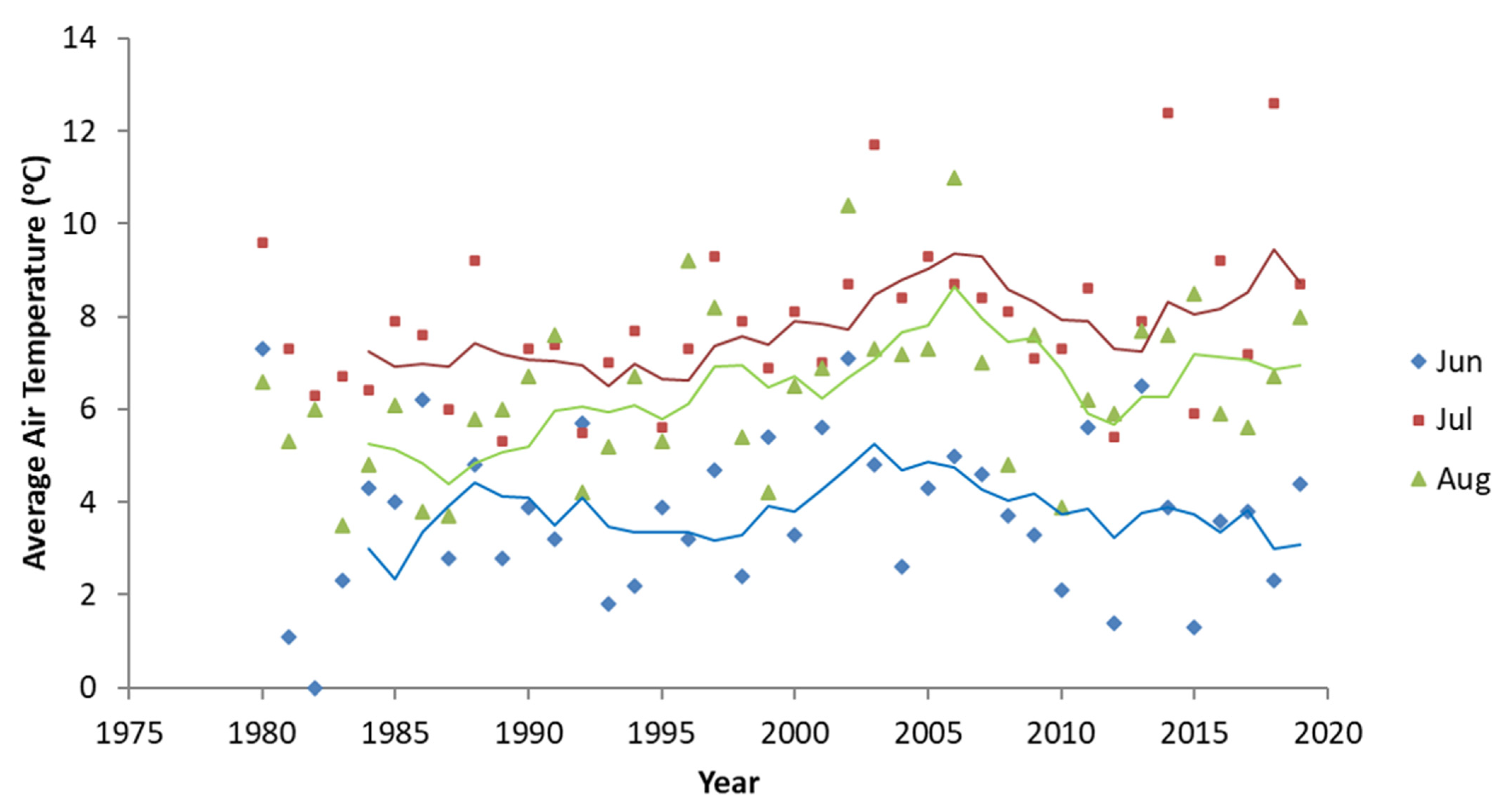
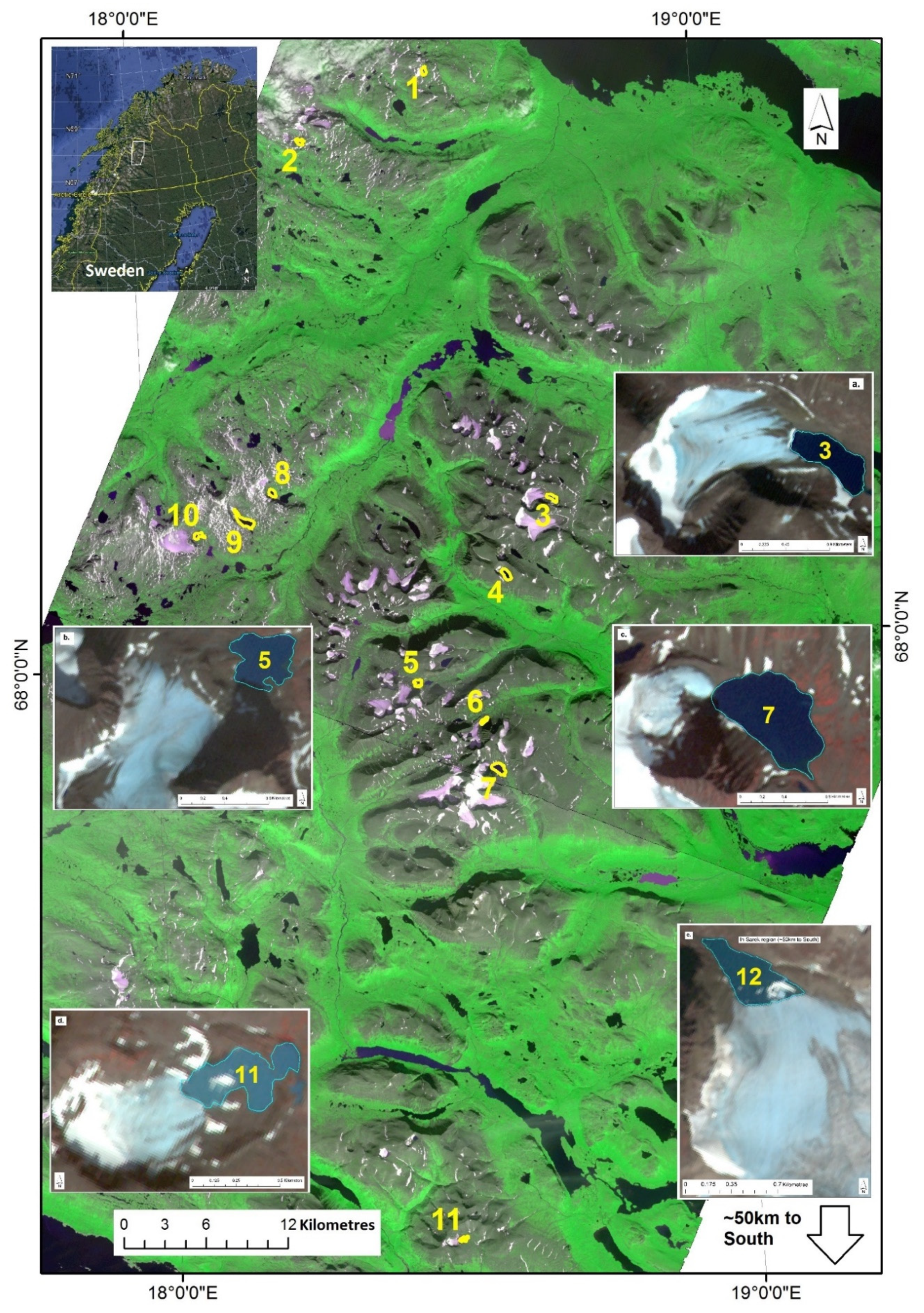
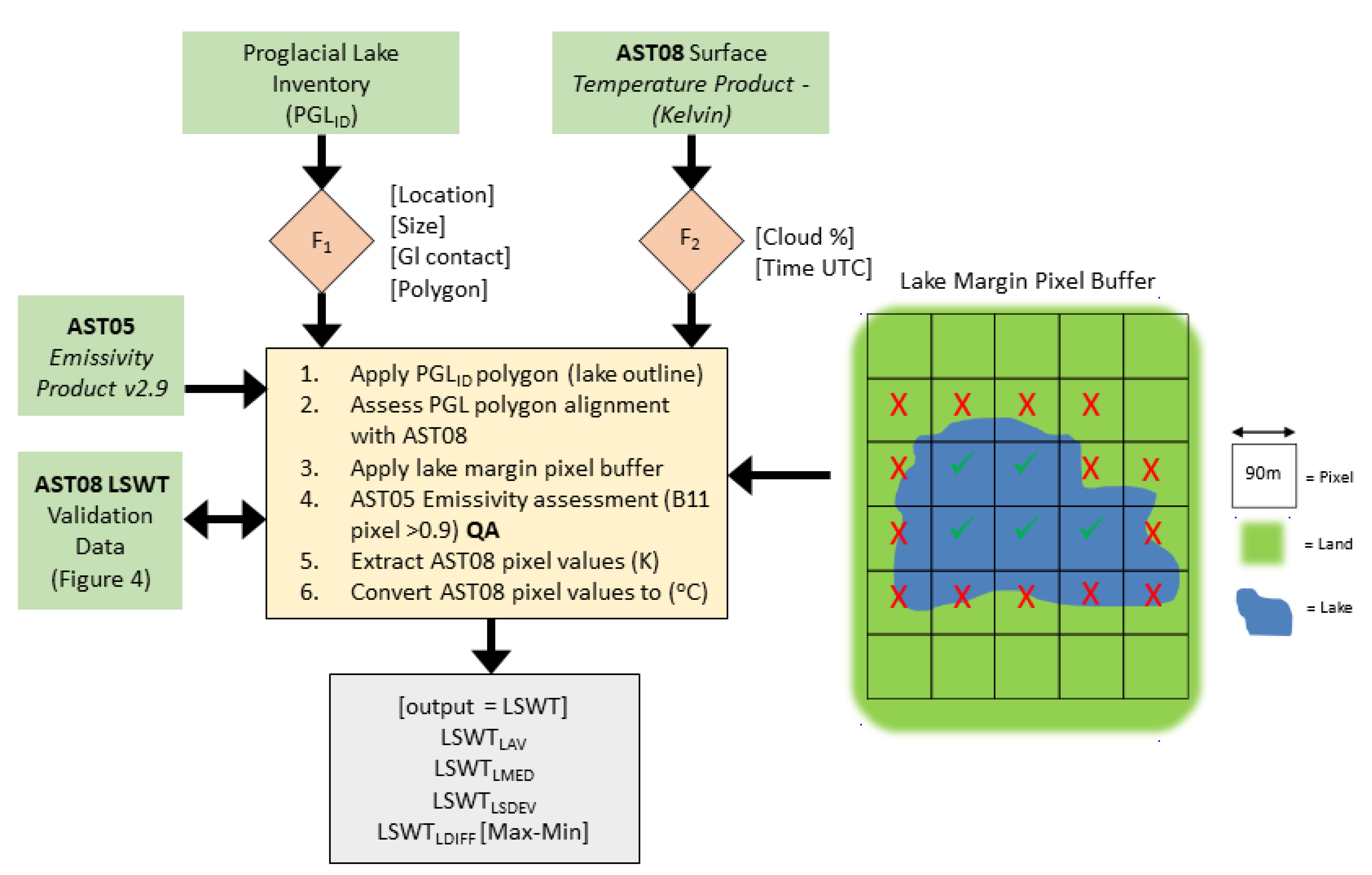
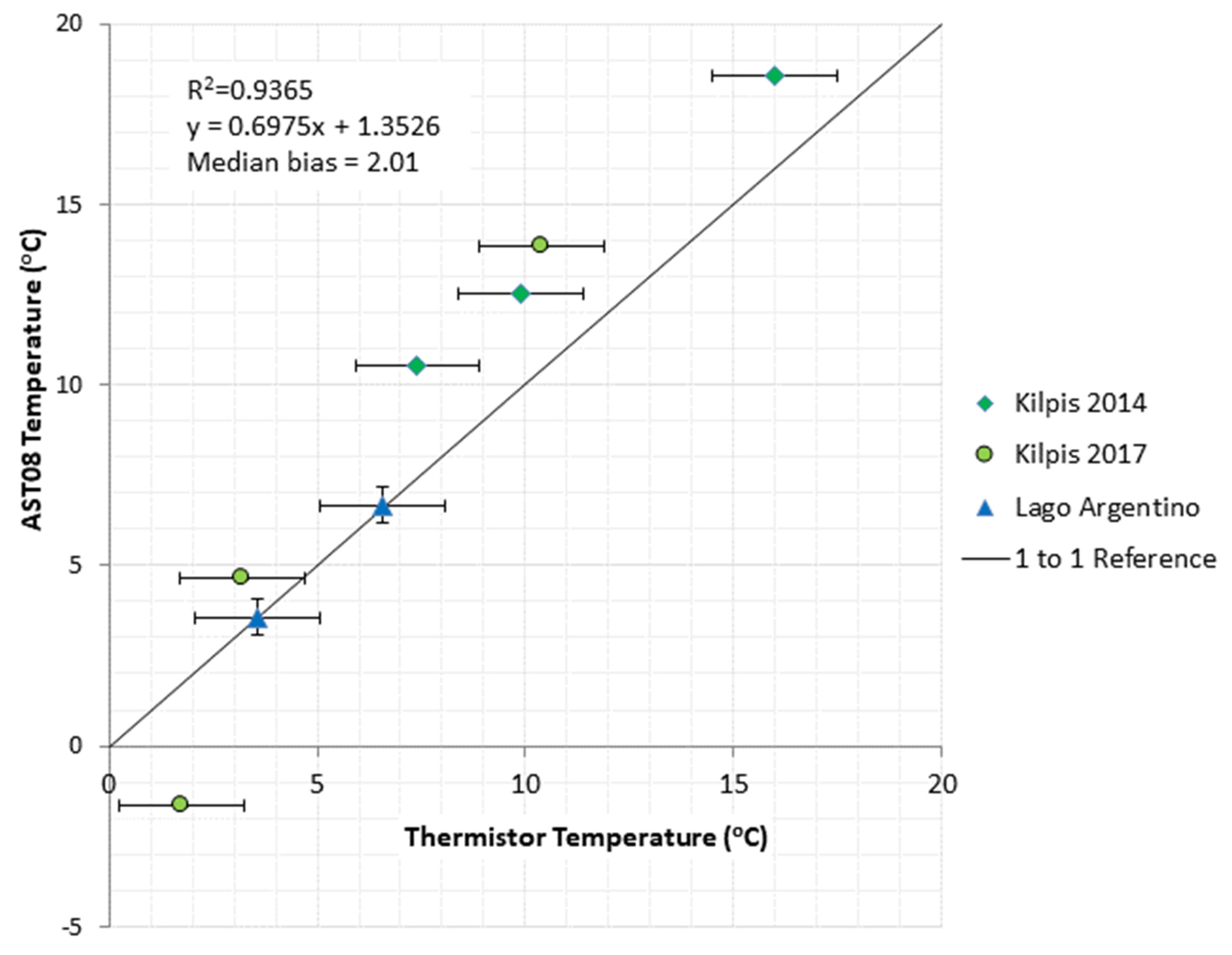
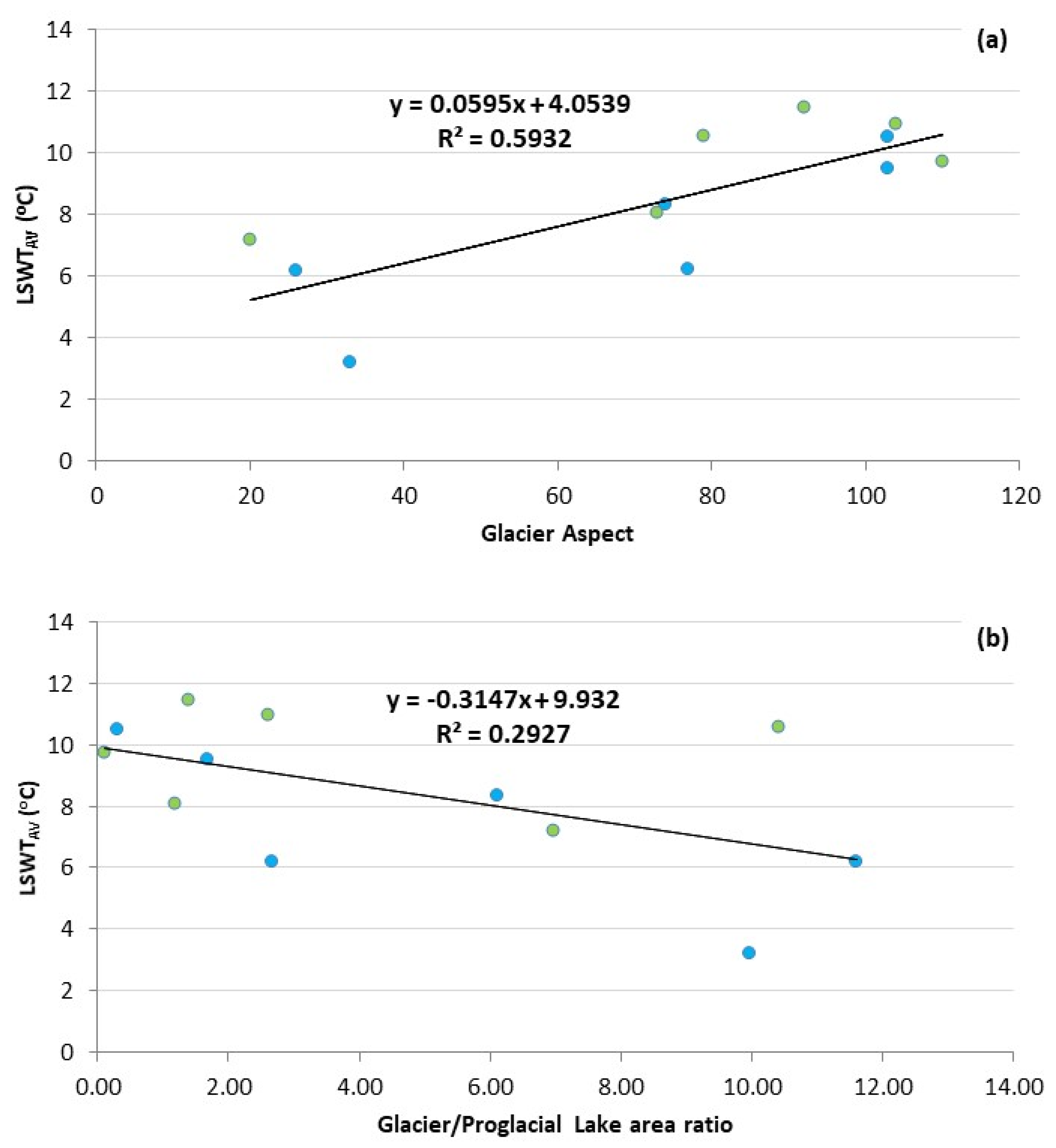
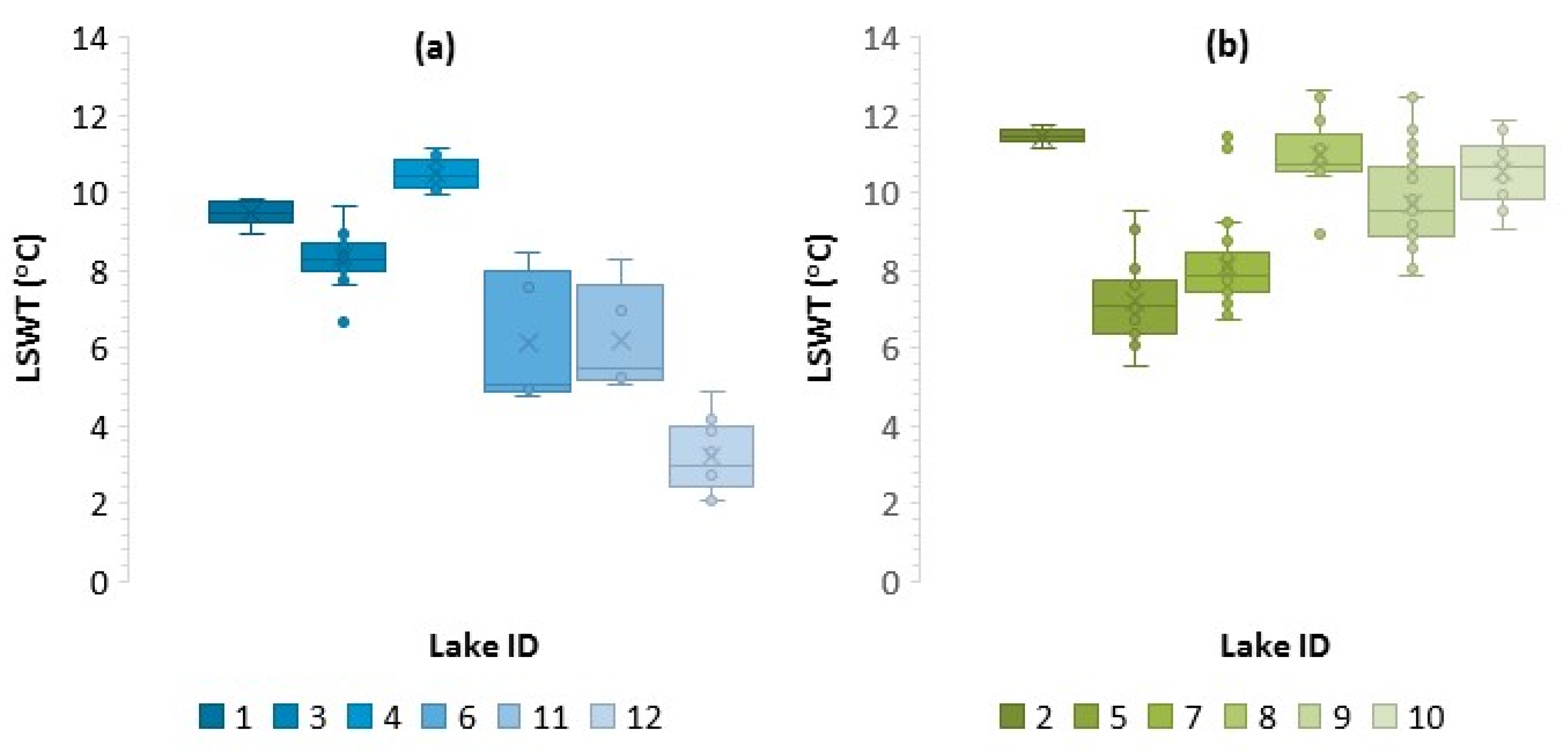
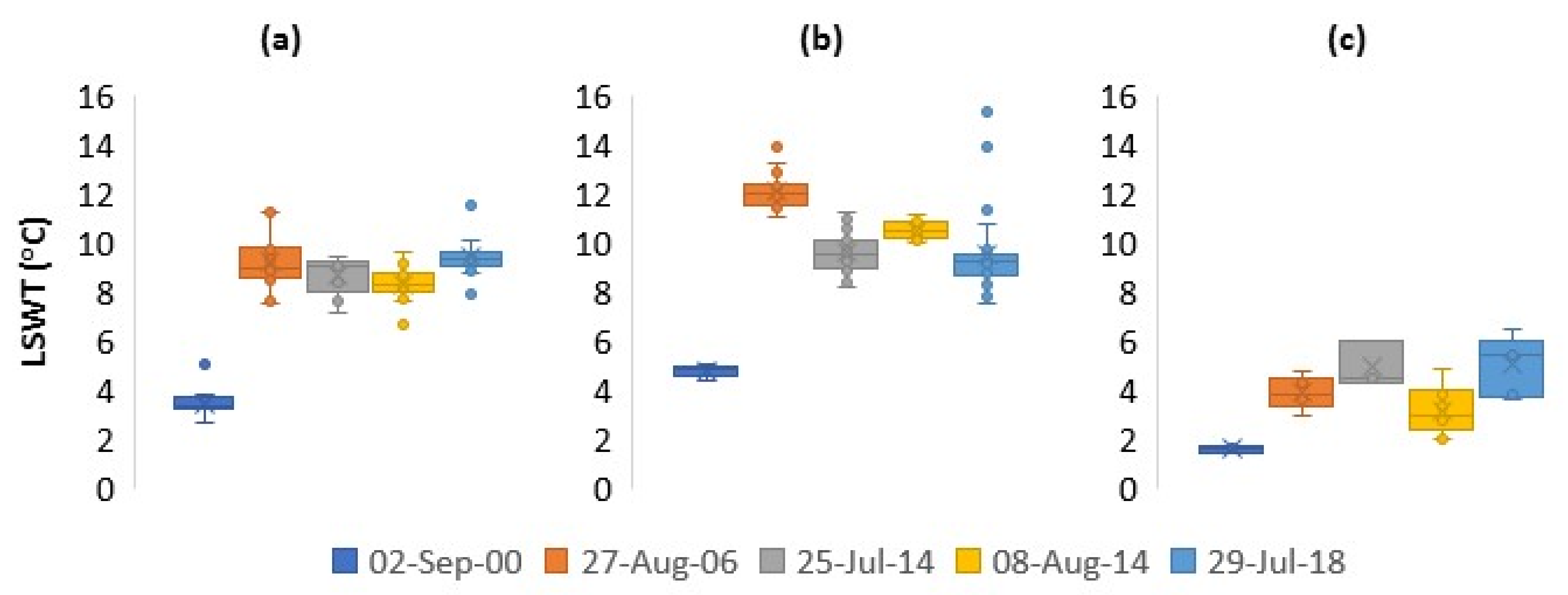

| AST08ID | LSWT AV (°C) | LSWT SDEV | ProGL Area (m2) | Depth (m) | Perim. (m) | Elev. (m) | Ice Contact | Glacier Area | Glacier Aspect |
|---|---|---|---|---|---|---|---|---|---|
| 1 | 9.5 | 0.30 | 157,516 | - | 1750 | 1267 | 1 | 265,647 | 103 |
| 2 | 11.5 | 0.19 | 163,140 | - | 2425 | 1144 | 0 | 227,518 | 92 |
| 3 | 8.3 | 0.67 | 242,736 | - | 2349 | 1318 | 1 | 148,6665 | 74 |
| 4 | 10.5 | 0.38 | 346,719 | - | 2519 | 1382 | 1 | 105,949 | 103 |
| 5 | 7.2 | 1.06 | 230,764 | - | 2372 | 1243 | 0 | 1,608,398 | 20 |
| 6 | 6.2 | 1.54 | 132,172 | ~20 | 1717 | 1124 | 1 | 1,533,959 | 26 |
| 7 | 8.1 | 1.03 | 560,589 | 49.8 | 3297 | 1194 | 0 | 670,186 | 73 |
| 8 | 11.0 | 0.91 | 211,513 | - | 1791 | 1123 | 0 | 552,809 | 104 |
| 9 | 9.7 | 1.13 | 686,233 | - | 4692 | 1169 | 0 | 71,160 | 110 |
| 10 | 10.6 | 0.84 | 220,826 | - | 2626 | 1090 | 0 | 2,301,468 | 79 |
| 11 | 6.2 | 1.23 | 149,143 | - | 2189 | 1227 | 1 | 398,244 | 77 |
| 12 | 3.2 | 0.89 | 175,832 | - | 2092 | 1441 | 1 | 1,755,474 | 33 |
Publisher’s Note: MDPI stays neutral with regard to jurisdictional claims in published maps and institutional affiliations. |
© 2021 by the authors. Licensee MDPI, Basel, Switzerland. This article is an open access article distributed under the terms and conditions of the Creative Commons Attribution (CC BY) license (https://creativecommons.org/licenses/by/4.0/).
Share and Cite
Dye, A.; Bryant, R.; Dodd, E.; Falcini, F.; Rippin, D.M. Warm Arctic Proglacial Lakes in the ASTER Surface Temperature Product. Remote Sens. 2021, 13, 2987. https://doi.org/10.3390/rs13152987
Dye A, Bryant R, Dodd E, Falcini F, Rippin DM. Warm Arctic Proglacial Lakes in the ASTER Surface Temperature Product. Remote Sensing. 2021; 13(15):2987. https://doi.org/10.3390/rs13152987
Chicago/Turabian StyleDye, Adrian, Robert Bryant, Emma Dodd, Francesca Falcini, and David M. Rippin. 2021. "Warm Arctic Proglacial Lakes in the ASTER Surface Temperature Product" Remote Sensing 13, no. 15: 2987. https://doi.org/10.3390/rs13152987
APA StyleDye, A., Bryant, R., Dodd, E., Falcini, F., & Rippin, D. M. (2021). Warm Arctic Proglacial Lakes in the ASTER Surface Temperature Product. Remote Sensing, 13(15), 2987. https://doi.org/10.3390/rs13152987






